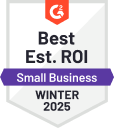10 perfect sales pitch examples and how to write your own

The quality of a sales pitch can be the difference between meeting or missing a monthly quota. Poor pitches, if not modified and improved, can sink a whole company, in fact. Sales pitches are the backbone of a company’s outward-facing activities, so making sure you have a solid one should be a top-line priority.
Key takeaways:
- Sales pitches shape leads’ first impressions. To make it effective, prioritize clarity over lengthy narratives, adjust strategy to the target audience (use personalized language), address problems, offer practical solutions, and stress benefits.
- Build credibility with facts and data, overcoming skepticism. Conclude with a clear Call to Action (CTA), directly inviting prospects to take the next step in the selling process.
- Examine effective marketing strategies employed by Lay’s, Apple, and Oatly to assess their narrative strength, ability to identify customer needs, and alignment with values.
- Apple confidently associates products with premium experiences; Wondery Podcast Network uses awards and a compelling slogan, “feel the story,” for a consistent brand tone. Learn from the best!
Land your sales pitches with real-time insights from CloudTalk
What is a sales pitch?
Sales pitches are, simply, presentations that sales representatives give when trying to convince a prospect to do business with their company.
Sales pitches are usually formulaic in nature, designed to capture the attention of their audience. They can be given verbally over the phone, or with accompanying visual materials in person.
Pitches can be directed at a variety of audiences, too. Investors, potential customers and budding business partners are just a few examples of people or entities one could call a prospect.
A sales pitch is usually the first exposure a prospect has to your company and its mission, so be sure to take the necessary time to develop a pitch that works for your agents and their prospects.
Read on for some tips about designing a professional, effective sales pitch.
How to make a great sales pitch
#1 Be clear and concise
Sales pitches should be delivered confidently by a salesperson who’s fully convinced of the efficacy of your product.
Their presentation should be right to the point — there’s nothing worse as a prospect than being dragged along a winding narrative road towards a weakly-made point. Salespeople that drone on and on bore their audience and risk losing business.
In short, don’t beat around the bush: time is money, and your prospects are better served by succinct sales pitches that use clear language to explain why your product is right for them.
#2 Identify and address your target audience
Identifying your target audience in the body of your sales pitch can help make your message feel personal.
For example, if you’re selling ready-made meals from a food delivery service, you could call out your target audience by saying something like, “Tired of having to figure out what to cook each and every night? With [company name], all the ingredients for a week of delicious dinners are delivered right to your door.”
If you choose to speak directly to your target audience, make sure to use broad, generic language so as not to alienate any potential customers.
Be sure to carefully tailor your sales pitches to each individual prospect. Never assume that a model that worked well for one presentation will work well for the next.
#3 Identify a problem they face, and explain how your product can help solve it
It’s often said that a salesperson’s secret sauce is presenting their product as the solution to a common problem. The first opportunity that they have to do this is through the sales pitch.
When coming up with the thrust of your pitch, you’ll want to identify and define a common problem that your target audience faces. Once that’s been introduced, you can present your product as the key to finally solving that problem.
#4 Give a practical example of your solution
The key here is to help them envision a reality where they’re actively using your product to address and finally solve a nagging problem.
Say, for example, you’re trying to sell fertilizer for people’s lawns in the dead of winter. As a sales representative in this scenario, you could talk about getting ready for springtime, and how lush and green the prospect’s lawn will look thanks to your fertilizer product. Assuming you’ve identified this prospect as someone who’s dissatisfied with their current lawn fertilizer, you could contrast last spring’s subpar lawn to the promise of this spring’s lawn.
The idea is to paint a picture for the prospect – one in which your product is the answer to all of their problems.
#5 Root your pitch in facts and data, and don’t forget the CTA!
Sales pitches work best when they’re anchored in plenty of facts and data. People are sometimes wary of salespeople and their tricks of the trade. Leaning on unfalsifiable facts and figures can disarm and eventually persuade even the most skeptical of prospects.
Finally, when you reach the end of your sales pitch presentation, don’t forget to include some sort of CTA (call to action). It can be something direct and explicit, like handing a prospect your business card and attempting to schedule a follow-up discussion; or something more subtle like mentioning that your email line is open should anyone have any lingering questions about your presentation.
The choice is yours; just ensure that you communicate in the right way, either by using the correct scripts or SaaS proposal templates. This will help you create a sales pitch presentation that leaves your prospects feeling excited about your product.
10 sales pitch examples
#1 Pitch from a Lay’s Salesperson to Investors about New Marketing Campaign
“Hi, my name is Jacob and I’m a representative from Lay’s potato chips. So nice to be with all of you today.
We’ve all been there, right? You come home from a long day at the office, wanting nothing more than to plop down in front of the TV with a good salty snack. You open your pantry and let out an exasperated sigh: nothing but plain potato chips. Nothing interesting, nothing unique, nothing that makes your mouth water.
It’s an all-too-familiar conundrum, and one that we here at Lay’s are determined to do something about.
That’s why we’ve recently begun a campaign that asks you, the consumer, to help us select a series of new potato chip flavors. We’ll engage with you across a range of platforms, crowdsourcing the insights necessary to keep all Lay’s snackers satisfied. Before you know it, we’ll all be living in a world full of flavor.
If you’ve got any questions about this new initiative or about our brand in general, my line is always open. We’re very much looking forward to seeing what we can build together.”
Notice how the presenter of this sales pitch uses a narrative to capture his audience’s attention. By placing the members of his audience in the shoes of someone dealing with a common problem — not having interesting enough snack foods at home — he is making his product relevant to the consumer.
By soliciting his consumer’s input, he is guaranteeing that they’ll be satisfied with the results of the campaign.
Lastly, we can appreciate how the salesperson’s playfulness with his language surrounding the product has the effect of putting his audience at ease, thus making them open to hearing new ideas.
#2 Booking Steve Wozniak as a Keynote Speaker
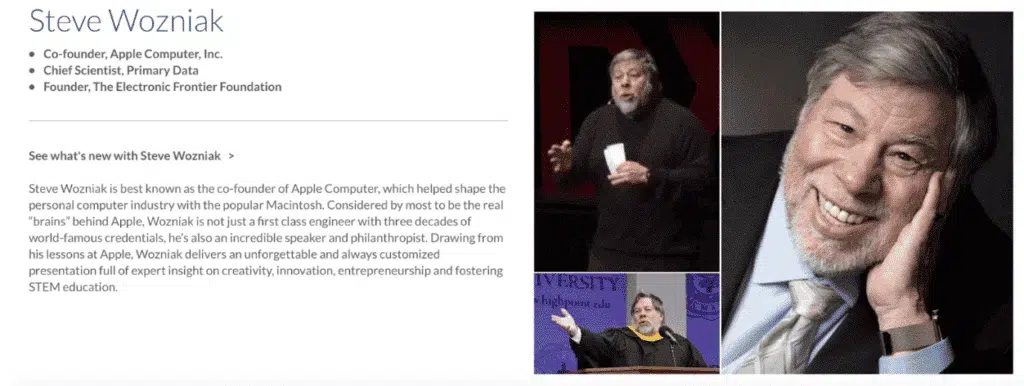
This sales pitch, directed at people looking for a high-profile keynote speaker for their event, gets right to the point by telling you who the speaker is and how they gained notoriety.
It continues by playing up Steve Wozniak’s many accomplishments, thus framing him as eminently qualified to speak at whatever event you may be holding.
The pitch then speaks to Wozniak’s oratory skills, describing his presentations as “unforgettable” and “full of expert insight” on a range of topics.
It even speaks directly to a likely academic target audience by mentioning Wozniak’s potential to inspire students in the STEM fields.
Reduce Missed Calls—Reserve a Demo Today!
#3 Oat-ly Drink Barista Edition

Oat-ly as a brand is well known for its unique voice and style. Conversational in tone, this sales pitch for Oat-ly’s Barista-Edition Oat Drink seeks to make a connection with its audience right off the bat, confidently assuming the reader is indeed a barista.
While one may think this is a risky move in sales copy — one that might alienate a large portion of their audience — it’s actually an effective way to naturally boast about the product’s merits as a foamable oat drink.
Overall, Oat-ly’s sales pitch for their Barista-Edition oat drink is an excellent example of how confident copy can win over your audience.
#4: Habitat for Humanity “Who we are”
Habitat for Humanity partners with people in your community, and all over the world, to help them build or improve a place they can call home. Habitat homeowners help build their own homes alongside volunteers and pay an affordable mortgage. With your support, Habitat homeowners achieve the strength, stability and independence they need to build a better life for themselves and for their families. Through our 2020 Strategic Plan, Habitat for Humanity will serve more people than ever before through decent and affordable housing.
Habitat for Humanity is a charity organization that helps to build homes for disadvantaged people all around the world. The “Who we are” section of their website’s About page serves as a sales pitch for prospective philanthropists.
The pitch begins by positioning Habitat for Humanity as a wide-reaching force for good. By emphasizing their experience in charitable home building, they’re assuring their audience that they know what they’re doing, and that their donation would be put to good use.
A key part of this sales pitch is the use of the phrase, “with your support”. It quite directly highlights the integral role that charitable donations play in the work that Habitat for Humanity is able to do. Furthermore, by addressing the reader directly — “with your support” — an element of urgency is added into the mix. The use of this sort of language places this “Who we are” paragraph squarely in solicitous, sales pitch territory.
Start calling with a complimentary virtual phone number for 14 days free!
#5 “Sell me this pen” scene, The Wolf of Wall Street (2013)
This scene from the 2013 blockbuster movie The Wolf of Wall Street speaks directly to one of the core tenets underlying any and every sales pitch: the identification and fulfillment of a need.
Unless your sales pitch clearly identifies the gap in the market that your product is attempting to fill, it will likely fall flat with your audience. In the case of the The Wolf of Wall Street scene, the final and best sales pitch comes from the salesman who makes his prospect’s need for his product painfully obvious. He’s able to do this by handing his prospect a piece of paper and asking him to sign his name. His prospect quickly realizes that in order to accomplish this task he needs a pen — exactly the product the salesman is trying to sell.
Of course, not all businesses sell pens and identifying an effective way to highlight the need your product fills may prove difficult. It’s well worth the effort, though, we assure you. As we can see in the “Sell me this pen” scene, the most effective sales pitches are those that demonstrate the usefulness of their products through the quick and clear identification of need.
#6 Alsace, France Tourism Brochure

This rather whimsical sales pitch from an Alsace, France tourism brochure cleverly positions the region and its many attractions as the subject of some sort of collective fantasy.
It’s a bold pitch, and one we’d argue is quite effective. Part of the attraction of travel is the chance to discover new and magical places. This sales pitch plays up the “magic” of Alsace and invites its audience to live out their dreams there.
There’s an important takeaway here for salespeople, and it’s this: try as best you can to associate your product with a widely-recognized ideal.
Say you’re selling sponges. Is it more effective to develop a sales pitch that highlights the quality of the material from which your sponges or made? Or would you be better off describing and showing images of spotless dishes and silverware that were cleaned using your sponges?
We’d argue that the spotless kitchenware pitch — the ideal that your product will help customers achieve — is the more effective sales strategy.
So whether you’re selling a dream-like holiday destination or a set of sponges, make sure your audience knows what your product can help them achieve.
#7 FlixBus Holidays Email
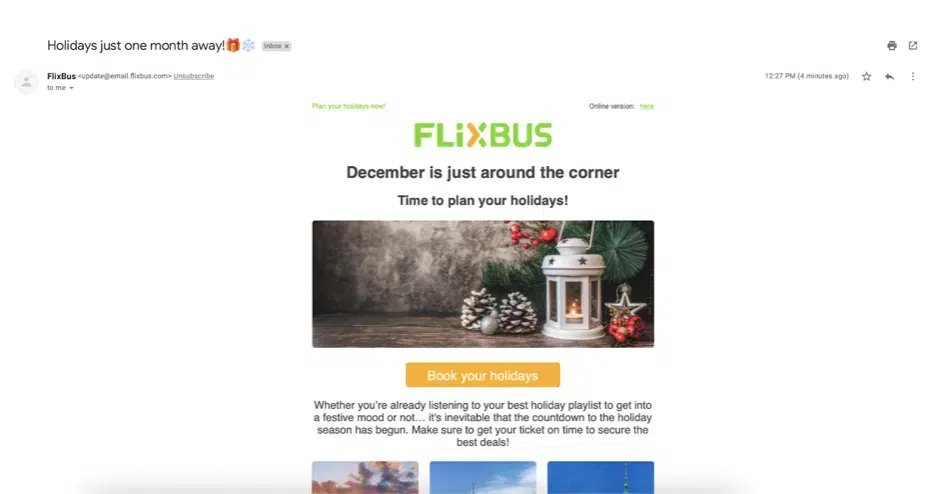
This email campaign from FlixBus demonstrates the utility of timeliness and urgency in sales. The lead text in the email is, “December is just around the corner… Time to plan your holidays!”. This kind of marketing message is effective because it takes advantage of the season, and has the added benefit of being extremely easy for a marketing team to organize. All your team would need to do is draft the email message and schedule it to be send one month before the holidays.
#8 Citi Bike membership
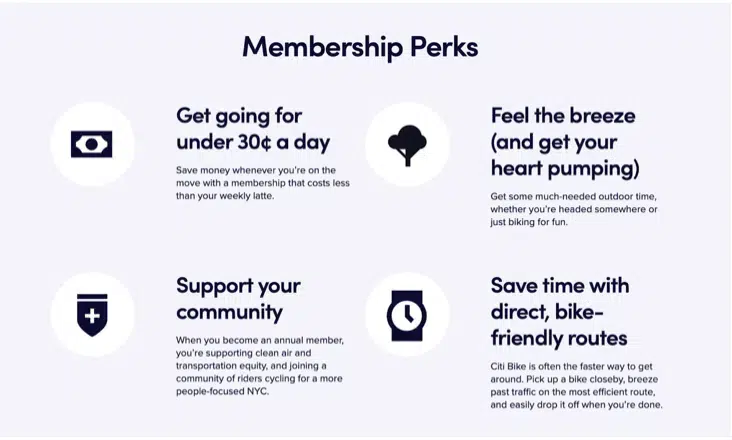
This sales pitch for NYC-based Citi Bike bicycle sharing program is jam-packed with useful information for potential customers. First, it breaks down the price of a membership to per-day cost. This is effective because it makes the membership seem supremely affordable. Next, it speaks to the health benefits of staying fit, something one can easily achieve by riding a bicycle regularly. The pitch continues by noting how more people riding bikes means less people driving cars, which is a net benefit for the environment. Finally, the audience is made aware that riding a bicycle in a traffic-jammed city like New York is often a quicker, more efficient way of getting around. Taken as a whole, this sales pitch demonstrates the effectiveness of giving your potential customers as much information as possible. People appreciate it, and feel secure knowing they have all they need to make an informed decision about using your product or service.
#9 Apple product pitch
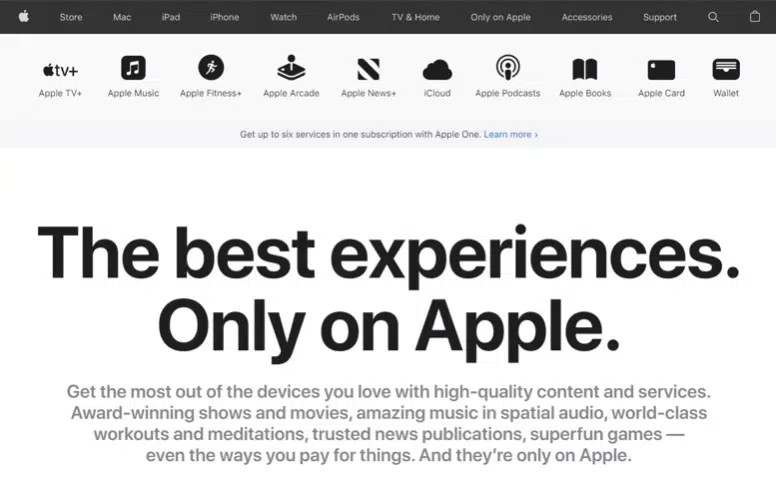
This simple, straightforward pitch begins with a two-sentence, eye-catching headline: “The best experiences. Only on Apple.”. The first sentence is confident, and sets the tone for the whole pitch. The product, Apple, should be associated with the best experiences, ful stop. Furthermore, these “best experiences” can only be had with Apple. Pretty compelling message, huh? The pitch continues by describing the many benefits of using Apple products, with a focus on high-quality entertainment. Overall, the pitch makes clear the benefit of being confident in your sales pitch copy.
#10 Wondery Podcast Network
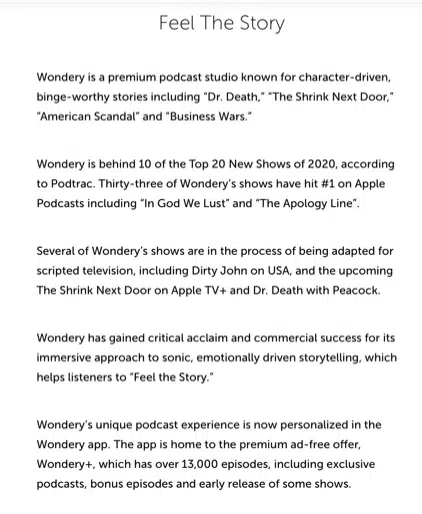
The Wondery podcast studio produces a wide-range of narrative podcasts, mostly focused on the historical drama genre. This pitch, on their website’s “about” page, starts off with a definition of the product. Notice how they use the phrase “binge-worthy”. Though it has become a sort of buzzword in audiovisual content production, it does speak strongly to the quality of content Wondery produces. The pitch goes on by highlighting several awards that the studio has won for its podcasts. A key takeaway from the pitch is its natural incorporation of the company’s slogan, “feel the story”. As a general rule, slogans are an effective means of ensuring your company’s messaging maintains a consistent tone throughout all of your various communications channels.
The Bottom Line
We hope our breakdown of how to craft effective sales pitches and the examples we analyzed will help you to more easily come up with your own.
After you’ve drawn up a clear, concise sales pitch, the next step will be to disseminate the pitch to your target audience. For this, you’ll need an easy-to-use, all-in-one communications platform. Lucky for you, we’ve got just the thing.
CloudTalk empowers salespeople all over the world to connect with prospects on crystal clear, jitter-free calls. It also helps marketers more efficiently schedule and execute campaigns with its bevy of useful automation tools and integrations to today’s most popular CRMs.
Want to see CloudTalk’s powerful features and integrations for yourself? Try a 14-day free trial today, absolutely free.























